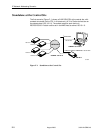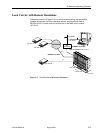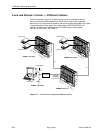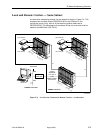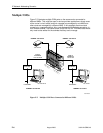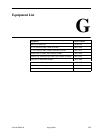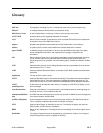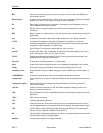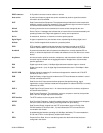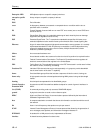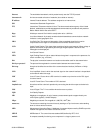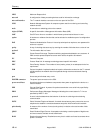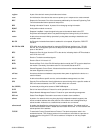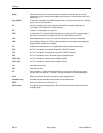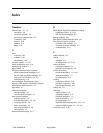
Glossary
GL-2
3162-A2-GB20-40
August 2000
Bursty Error Seconds. A second in which more than one but less than 320 CRC6 error
events have occurred.
A signal in which successive ones (marks, pulses) are of alternating positive and negative
polarity, and in which a zero (space, no pulse) is of zero amplitude.
Binary digit. The smallest unit of information, representing a choice between a one or a
zero (sometimes called mark or space).
Bits per second. Indicates the speed at which bits are transmitted across a data
connection.
Bipolar Violation. In a bipolar signal, a one (mark, pulse) which has the same polarity as its
predecessor.
A sequence of successive bits (usually eight) handled as a unit in data transmission.
Consultative Committee on International Telegraphy and Telephony. An advisory
committee established by the United Nations to recommend communications standards
and policies. It was renamed ITU in March 1993.
Carrier Detect. The received line signal detector. V.24 circuit 109.
A bidirectional DS0, voice, or data path, for electrical transmission between two or more
points. Also called a circuit, line, link, path, or facility.
Challenge Handshake Authentication Protocol. A security technique that allows a user
password to be encrypted for transmission.
A letter, figure, number, punctuation, or other symbol.
A device that receives a specific service, such as database management, from a server.
A technique used to accommodate the ones density requirements of E1 lines.
An identification used by an SNMP manager to grant an SNMP server access rights to a
MIB.
A proprietary product family name and a registered trademark of Paradyne.
The arrangement of a system or network as defined by the characteristics of its functional
units.
Device software that sets specific operating parameters for the device. Sometimes
referred to as straps.
Central Processing Unit failure. A Self-Test Health message indicating a failure in the
device’s central processing unit.
Cyclic Redundancy Check. A mathematical method of confirming the integrity of received
digital data.
CRC using six check bits.
Canadian Standards Association.
Channel Service Unit. A device that connects service user equipment such as a DSU to
the local digital telephone loop, protects the line from damage, and regenerates the signal.
Clear To Send. A signal indicating that the device is ready for the DTE to transmit data.
Usually occurs in response to Request To Send (RTS).
The transmission standard that specifies 12 frames as a superframe that is used for frame
synchronization and to locate signaling bits.
An organized compilation of computerized data.
BES
bipolar signal
bit
bps
BPV
byte
CCITT
CD
channel
CHAP
character
client
coding
community name
COMSPHERE
configuration
configuration option
CPU fail
CRC
CRC6
CSA
CSU
CTS
D4
database



